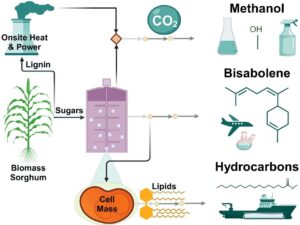Volume 19 Issue 3
Latest articles
- Editorialpp 4040-4042Lan, K. (2024). “Some modeling challenges in dynamic life cycle assessment,” BioResources 19(3), 4040-4042.AbstractArticlePDF
Life cycle assessment (LCA) has been a mainstream tool to evaluate the environmental impacts of products, services, and systems. Current LCAs inherently rely on the static basis and commonly fail to include temporal considerations. To better assist in the decision-making for sustainable development, dynamic LCA has been initiated to answer more complex and interdisciplinary questions. As in its initial phase, dynamic LCA faces many modeling challenges that at the same time are meaningful research opportunities. In modeling dynamic LCA, there are several key aspects that need more attention for contribution and close collaboration across the first three phases of the LCA framework.
- Editorialpp 4043-4046Zhang, J., and Pal, L. (2024). “Paper drinking straws coated with cellulose acetate and polyhydroxyalkanoates via an entropy-driven approach and natural colorants as alternatives for plastic drinking straws,” BioResources 19(3), 4043-4046.AbstractArticlePDF
As a way to reduce microplastics or nano-plastics in the ocean, it is of interest to develop biodegradable paper-based drinking straws to replace non-degradable plastic drinking straws. Primary questions to be addressed include how to design suitable coatings for paper drinking straws. Such coatings not only need to resist water. In addition, consumers have high expectations for the strength of a drinking straw. It is proposed here to replace non-biodegradable polypropylene, which is presently the main component of straws, with biodegradable and hydrophobic coating components via an entropy-driven approach. It is further proposed to develop colored paper-based drinking straws with cellulose nematic liquid crystal photonic pigments as a way to make the product stand out visibly, while at the same time mediating the usage of toxic chemical pigments.
- Editorialpp 4047-4049Zhang, S., Zhang, Q., Guo, X., and Zhu, S. (2024). “Kudzu: An invasive plant or a sustainable resource,” BioResources 19(3), 4047-4049.AbstractArticlePDF
Kudzu (Pueraria lobata (Willd.) Ohwi) is a fast growing leguminous vine plant that has strong reproductive ability and low requirements on its growing conditions. It has been considered an invasive plant in some places because of its aggressive growth, which can destroy the habitat for native plants and animals. However, its strong environmental adaptability makes it easily cultivated as a sustainable resource. Kudzu can also keep soil from washing away and play an important role in ecological protection. Kudzu has had numerous practical uses in our daily lives since ancient times. For example, its root, stem, flower and pod are used in traditional Chinese medicine. Its root is a healthy food. And its leaf is used as fodder and forage for livestock. Moreover, some recent studies on kudzu have found that it is in rich of bioactive ingredients, especially isoflavones, which further broadens its uses in medicine, healthy food, and cosmetics industries. Its high starch and cellulose content makes it a promising feedstock for biofuel production and paper preparation. This editorial will give a brief discussion on kudzu and its comprehensive utilization.
- Editorialpp 4050-4052Yuan, Z. (2024). “Graphene-cellulose hydrogels: An apt combination,” BioResources 19(3), 4050-4052.AbstractArticlePDF
Graphene-cellulose hydrogels have been extensively studied in the field of functional hydrogels. This editorial presents an overview of graphene-based and cellulose-derived materials, highlighting the unique characteristics of these two materials and the synergistic advantages achieved by combining them to construct graphene-cellulose composite hydrogels. The aim is to provide novel insights for developing functional cellulose-based hydrogels enabled by carbon nanomaterials.
- Editorialpp 4053-4055Hubbe, M. A. (2024). “Artists, papermakers, and the future,” BioResources 19(3), 4053-4055.AbstractArticlePDF
This editorial considers three groups of individuals and how they often find themselves following common ways of thinking. Artists, especially those who become well known, are hard workers and somewhat stubborn. Once they have found a type of paper that works well for them, they tend to develop loyalty to it, regardless of what the label on the ream wrap may say. Papermakers, ancient and modern, likewise have tended to stick with practices that are convenient to them at the moment, whether or not they contribute to archival quality. Fortunately, the transition to alkaline papermaking practices means that modern printing papers tend to last a lot longer. Increasing knowledge of the importance of acid-free paper, as well as the principles of sustainability, are making positive contributions to our ongoing cultural heritage, at least to the part of that heritage that is related to cellulosic materials.
- Researchpp 4056-4086
Baral, N. R., Banerjee, D., Mukhopadhyay, A., Simmons, B. A., Singer, S. W., and Scown, C. D. (2024). “Integration of genome-scale metabolic model with biorefinery process model reveals market-competitive carbon-negative sustainable aviation fuel utilizing microbial cell mass lipids and biogenic CO2,” BioResources 19(3), 4056-4086.AbstractArticlePDF Award Winner: 2023 BioResources Early Career Investigator Award
Award Winner: 2023 BioResources Early Career Investigator Award
Producing scalable, economically viable, low-carbon biofuels or biochemicals hinges on more efficient bioconversion processes. While microbial conversion can offer robust solutions, the native microbial growth process often redirects a large fraction of carbon to CO2 and cell mass. By integrating genome-scale metabolic models with techno-economic and life cycle assessment models, this study analyzes the effects of converting cell mass lipids to hydrocarbon fuels, and CO2 to methanol on the facility’s costs and life-cycle carbon footprint. Results show that upgrading microbial lipids or both microbial lipids and CO2 using renewable hydrogen produces carbon-negative bisabolene. Additionally, on-site electrolytic hydrogen production offers a supply of pure oxygen to use in place of air for bioconversion and fuel combustion in the boiler. To reach cost parity with conventional jet fuel, renewable hydrogen needs to be produced at less than $2.2 to $3.1/kg, with a bisabolene yield of 80% of the theoretical yield, along with cell mass and CO2 yields of 22 wt% and 54 wt%, respectively. The economic combination of cell mass, CO2, and bisabolene yields demonstrated in this study provides practical insights for prioritizing research, selecting suitable hosts, and determining necessary engineered production levels.
- Researchpp 4087-4103Ji, H., Yang, Y., Zhang, H., Li, B., and Cheng, L. (2024). “Decay level classification of wooden components in Tingbao Yang’s former residence utilizing polarization and fluorescence effects,” BioResources 19(3), 4087-4103.AbstractArticlePDF
Decay levels of wooden components in the Yang former residence were classified using polarized light and fluorescence methods. Analysis of the decay cause was conducted based on external conditions and wood species characteristics. The polarization and fluorescence effects revealed that there were varying degrees of decay in larch (Larix potaninii var. australis), spruce (Picea brachytyla), lace-bark pine (Pinus bungeana), Masson pine (Pinus massoniana), Chinese Douglas fir (Pseudotsuga sinensis), Chinese fir (Cunninghamia lanceolata), poplar (Populus tomentosa), and elm (Ulmus pumila). The primary factors contributing to decay included the inherent low natural durability of the wood species and adverse external conditions, such as damaged roofs, missing dripping water and tiles causing water leakage, uneven indoor and outdoor ground levels, contemporary tile paving indoors, and inadequate ventilation. This study aims to establish a scientific basis for subsequent conservation strategies.
- Researchpp 4104-4119Radmanović, K., Balaško, K., Pervan, D., Lončar, F., Dujmović, M., and Šafran, B. (2024). “Determining thermal properties of beech and fir wood samples in longitudinal direction via modified transient plane source method,” BioResources 19(3), 4104-4119.AbstractArticlePDF
The increasing use of wood leads to the need for a better understanding of its thermal properties with the aim of quantitatively identifying the exchange of thermal energy between wood and the surrounding solar radiation as precisely as possible. Reliable and rapid measurement of thermal conductivity is one of the most important current industrial requirements. The aim of this study is to examine the validity of using the modified transient plane source method (MTPS), which uses the principle of one-sided heating of the sample, and is defined by the ASTM D7984-21 (2021) standard, for determining the thermal conductivity of complex biocomposite composite materials such as wood. The analysis of the available literature shows a lack of data on the thermal conductivity of the type of wood originating in Croatia. In this study, the thermal conductivities of beech and fir wood samples in the longitudinal direction was determined by the MTPS method depending on the temperature and moisture content in the samples. Measurements were made on samples with a moisture content of 0%, 10%, and 20% in the temperature range from 20 to 80 °C.
- Researchpp 4120-4134Singer, H. (2024). “Location selection for a lumber drying facility via a hybrid Pythagorean fuzzy decision-making approach,” BioResources 19(3), 4120-4134.AbstractArticlePDF
The strategic selection of facility locations plays a critical role in optimizing operational efficiency, reducing costs, and enhancing customer satisfaction, thereby contributing significantly to the success and competitiveness of businesses. In this study, an interval-valued Pythagorean fuzzy decision-making framework is proposed to select the best location for the lumber drying industry. A four-level hierarchical model is devised with four main criteria, 16 subcriteria, and five alternatives. The opinions of different experts are gathered to obtain input data. The weights of the criteria are calculated using the interval-valued Pythagorean fuzzy analytic hierarchy process (AHP) method. The interval-valued Pythagorean fuzzy weighted aggregated sum product assessment (WASPAS) method is employed to evaluate the alternative locations. A sensitivity analysis is conducted to support the validity of the model results. The study concludes by revealing the optimal location for the lumber drying industry in Turkey. This study presents its novelty by formulating the lumber drying facility location selection problem as a complex fuzzy multicriteria decision-making problem and integrating the Pythagorean fuzzy AHP and WASPAS methods to solve the problem.
- Researchpp 4135-4154Kurul, F., and As, N. (2024). “Visual and machine strength gradings of Scots and red pine structural timber pieces from Türkiye,” BioResources 19(3), 4135-4154.AbstractArticlePDF
Scots (Pinus sylvestris L.) and red pine (Pinus brutia Ten.) structural timbers (540 pieces) from Türkiye were first visually graded according to TS 1265 (2012). Then, non-destructive tests were conducted using vibration and time of flight (ToF) methods, followed by destructive tests on a four-point bending test setup according to EN 408 (2012). The vibration method showed a higher correlation than ToF with strength and stiffness. The dynamic modulus of elasticity (MOEd) obtained by the vibration method was 12.3% and 15.4% lower in Scots and red pine, respectively, compared to the ToF method. Mechanical testing determined local MOE was 14% and 15% higher than global MOE for Scots and red pine, respectively. An alternative formula to the existing conversion formula in EN 384 (2018) was derived. The average bending strength of red pine was 7% higher than Scots pine. For visual strength grading, local and global MOE in Scots pine, class 1, 2, and 3 structural timbers were assigned to C35, C27, and C22, respectively. Red pine was assigned to C40, C27, and C24 for local MOE and C35, C24, and C22 for global MOE. In machine strength grading, the grade combination was C40-C30-C22-C16-R for both species. The best results were achieved in settings where vibration method and local MOE were used together. Machine strength grading achieved higher efficiency than visual strength grading.
